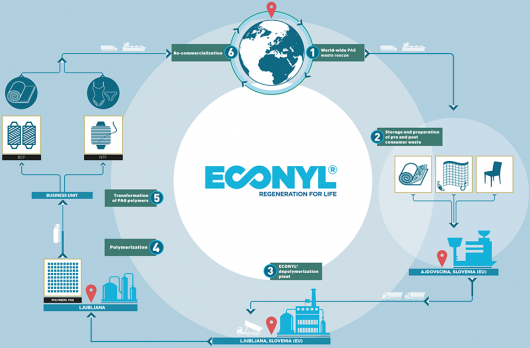ARTIFICIAL VS. NATURAL
 Il ciclo di produzione della fibra Econyl
Il ciclo di produzione della fibra Econyl
In principio furono il cotone e la lana. Puri, anzi, purissimi. In omaggio ad un mondo sempre più allergico e sempre più “affamato” di prodotti biologici e non contraffatti, la prima parola d’ordine della moda etica è stata “ritorno alla natura”, con le etichette che garantivano origine e trattamenti rispettosi di pelle e ambiente, diventati oramai un’ossessione. Il consumatore finale ha scelto per anni un prodotto rispetto ad un altro proprio basandosi sull’esclusione netta del sintetico, figlio del petrolio, quindi inquinante, quindi dannoso. Cibo bio, vestiti bio, casa bio: l’inquinamento ambientale non si è mosso di un centimetro ma la morale era salva. Persino la grande distribuzione ha piegato la testa davanti alla richiesta inondando il mercato di puro cotone non trattato e grigiastro o di lana vergine, pungente ma eticamente valida. Poi, la svolta. Davanti alla scarsa performance di molti capi totalmente naturali, l’industria ha iniziato a creare un tessile sintetico che nasconde un’idea vincente: il riciclo. E l’idea è passata. Oggi molte aziende si fanno un vanto di utilizzare filati non naturali. Sia perché aiutano a salvare l’ambiente, sia perché corrispondono a quel concetto di “cruelty free” nei confronti degli animali che si è fatto largo anche nel fashion (Stella McCartney docet), sia perché il risultato finale è oggettivamente buono. Un esempio viene da Econyl, una fibra del gruppo italiano Aquafil nata dalle reti da pesca e da materiali di scarto, che si è fatta strada nel mondo della moda scalandolo fino ai vertici, dagli originari costumi Speedo (per la quale è nata), fino a Levi’s, per approdare poi a Gucci. Che ha annunciato il suo utilizzo per la prossima collezione uomo, una delle più attese dell’anno. Sintetico è bello quindi, specie se l’azienda produttrice certifica che la sua fabbricazione è stata eseguita senza onere per l’ambiente. Tessuti uno e due, come la Signora Morli pirandelliana quindi. Diversi modi di vedere le cose. Di certo una prova di quanto composito sia il mondo di chi vuole aiutare il pianeta passando dalla moda. Luisa Ciuni
First there were cotton and wool. Pure, so pure. As a tribute to a more allergic and organic-addicted world, the keyword of ethical fashion was “return to nature”, with labels that guaranteed origin and treatments respectful of skin and environment, a kind of obsession. The final consumer has chosen for years a product instead of another on the basis of the clear exclusion of the synthetic, deriving from petroleum, therefore polluting, therefore damaging. Organic food, organic clothes, organic houses: the environmental pollution wasn’t solved but the ethics was safe. Even the large retailers tried to satisfy the request filling the stores with pure (and grayish) cotton and virgin wool, stinging but ethically correct. Then the turning point. Considering the weak performance of lots of totally natural garments, the fashion industry has started to produce synthetic fabrics with a winning idea behind: recycling. Today many companies are proud to announce that they use artificial yarns. Because they help to save the planet and correspond to that idea of “cruelty free” loved by the fashion system (Stella McCartney docet) and because the final result is objectively good. An example comes from the italian group Aquafil that created the fiber Econyl from fishing nets and waste materials, that, from the Speedo swimming costumes (which was created for), was adopted by Levi’s and then Gucci. That announced this partnership for its next menswear collection. So, synthetic is good, mainly if the company certifies that its production is respectful for the environment. Completely different points of view. Surely a proof of how the world of who wants to help the planet through fashion is composite. Luisa Ciuni
NESSUN COMMENTO





